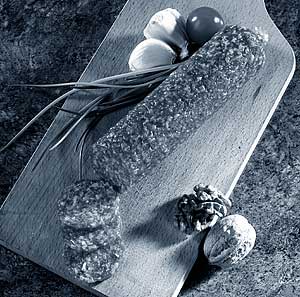
Edition 12 - November, 2002
 Edition 12 - November, 2002 |
Tetracycline resistance in lactic acid bacteria isolated from fermented dry sausages |
Since the introduction of antibiotics, now over 50 years ago, the greatest threat from the worldwide use of antimicrobial agents has been the development of antibiotic resistance in pathogenic bacteria. The magnitude of the problem is significantly increased by the overuse and misuse of antibiotics, which has triggered the selection and dissemination of resistant bacteria, and by the ability of bacteria to transfer antibiotic resistance genes horizontally. Clinical practices and animal husbandry are powerful foci of selective antibiotic pressure (3), and reservoirs of antibiotic resistance determinants in humans and animals have been shown to interact via various ecological routes, including the human food chain (5). Enteric bacteria can be readily transmitted through foods, as are antibiotic resistant pathogens and commensals. Although it has been well documented for zoonotic pathogens (4), very few attempts have been made to study the spread of antibiotic resistance genes by commensal bacteria. Over the last decade, it has become clear that commensal bacteria may act as reservoirs for resistant genes and are thus important in our understanding of how antibiotic-resistant genes are maintained and spread through bacterial populations.
 |
In order to obtain information on reservoirs of antibiotic resistance, an detailed
study on tetracycline resistant (Tcr) lactic acid bacteria (LAB) in fermented
dry sausages (FDS) end products as a model case was conducted at the Laboratory
of Microbiology of the Ghent University in Belgium. We found that several samples
of ready-to-eat FDS contained a subpopulation of Tcr LAB in a concentration
of 1.7 – 5.1 log CFU/g meat (1). Out of these positive samples a set of
Tcr LAB strains was isolated for further characterization. These strains were
typed and identified using (GTG)5-PCR fingerprinting (2). Among the isolates,
five different Lactobacillus taxa were found: Lb. plantarum, Lb. sakei subsp.
carnosus, Lb. sakei subsp. sakei, Lb. curvatus, and Lb. alimentarius. All these
species have been associated with fermented meat, and, except for Lb. alimentarius,
they are particularly well adapted to conditions created in FDS and so are frequently
used in meat starter cultures. Using PCR-based detection of the tetracycline
resistance genes (tet genes), we found tet(M) in the set of Tcr isolates. According
to the literature, the most prevalent tet genes among gram-positive bacteria
are tet(M), tet(O), tet(S), tet(K), and tet(L). Further characterization of
the tet(M) genes by sequencing revealed high sequence similarity with the previously
reported tet(M) genes of two pathogenic species Neisseria meningitidis and Staphylococcus
aureus. The tet(M) genes in our isolates could be localised mainly on plasmids,
and some of these R-plasmids were transferable by conjugation to other gram-positive
bacteria, including Enterococcus faecalis. One isolate contained an erm(B) gene
coding for erythromycin resistance in addition to the tet(M) gene. An analysis
of the prevalence and diversity of Tcr LAB and their tet genes along the process
line of FDS demonstrated that similar tet genes and host organisms can be found
along the process line from the raw meat to the end product. Moreover, this
study has indicated that not the starter culture but mainly the raw meat components
are a likely source of Tcr LAB in the end product.
Our findings indicate that lactobacilli can be hosts for acquired-resistance
genes in fermented meat products and may spread their resistance through bacterial
populations. However, knowledge of the mechanisms of antibiotic resistance in
LAB and its transmissibility is still very limited. Because LAB are extensively
used for food and feed, including starter cultures for fermentation, probiotic
cultures, and protective cultures to inhibit specific spoilage organisms, this
knowledge is becoming increasingly important for food-safety issues. The detection
of antibiotic resistance in FDS-associated bacteria may be extrapolated to resistance
in bacteria from all the environments in which food for human consumption is
produced. Clearly, future efforts in keeping antibiotics effective for the treatment
of bacterial infectious diseases should penetrate to all levels of the ‘food
web’.
 |
Contact
Dirk Gevers
Laboratory of Microbiology
Ghent University
K.L. Ledeganckstraat 35, B-9000 Gent
E-mail: dirk.gevers@rug.ac.be
LabSite: http://lmg.rug.ac.be
More info on this work: http://lmg.rug.ac.be/gevdi
Home |
Contents Edition 12 - November, 2002 |